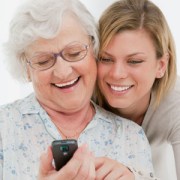Safety Tips For Seniors
Home accidents are a major cause of injury and death, especially for those over 60. As people grow older, they may be less agile and their bones tend to break more easily. A simple fall can result in a disabling injury. All patients need to take special precautions to ensure a safe living environment. Most accidents in the home can be prevented by the elimination of hazards. Use the attached checklists to determine the safety level of your home. Check each statement that applies to your home or to your habits in your home. Then review the unchecked boxes to determine what else you can do to make your home a safer place to live.
General Safety
Emergency Phone numbers are posted by each telephone
- Outside doors are kept locked at all times and not opened to an unfamiliar face. Ask for identification and call someone to verify who they say they are.
- Door-to-door salesmen are not let into your home. They are asked to come back when a friend or family member will be with you.
- Valuables that may be easily stolen are kept out of sight.
- Telephone and television solicitations are not accepted. “If it sounds too good to be true, it probably is.”
- Household maintenance (painting, roofing, etc.) is scheduled with a reputable company. Have a friend or family member assist you.
Electrical Safety
- Electrical appliances and cords are clean, in good condition and not exposed to liquids.
- Electrical equipment bears the Underwriters Labs (UL) label.
- An adequate number of outlets are located in each room where needed.
- There are no “octopus” outlets with several plugs being used. Electrical outlets are grounded.
- Lighting throughout the house is adequate.
- Burned out lights are replaced.
Preventing Falls
- Stairways and halls are well lighted.
- Night-lights are used in the bathroom, halls and passageways.
- A flashlight with good batteries or a lamp is within easy reach of your bed.
- Throw rugs are removed or have a nonskid backing and are not placed in traffic areas.
- All clutter is cleared from the house, especially from pathways.
- Electrical and telephone cords are placed along walls – not under rugs –
and away from traffic areas and do not cross pathways. - There are no step stools without high handrails.
- Handrails are used on stairs and securely fastened
- Grab bars are installed by the shower, tub or toilet.
- Shower stools or non-skid strips are attached to bottom of tub
- Elevated toilet seats and stools are used, if needed.
- Spills are cleaned up immediately
- Outside walks are kept clear of snow and ice in the winter.
- You are aware of any medications being taken which may cause dizziness or unsteadiness
- Alcoholic beverages are limited to no more than two per day.
- When in a seated or lying down position, stand up slowly.
- A cane can be used for extra stability.
- Steps and walkways are in good condition and are free of objects
- Steps have non-skid strips or carpeting is securely fastened and is free from holes and fraying
- Light switches are located at the top and bottom of stairways and at both ends of long halls
- Doors do not swing out over stair steps
- Clearance in the stairway provides adequate head room
- Porches, balconies, terraces and other elevations or depressions are protected by railings or otherwise protected.
Kitchen Safety
- Curtains are kept away from the stove and other open flame areas.
- An exhaust hood with filters is present which discharges directly to the outside. The fan is turned on when cooking.
- Counter space is kept clean and uncluttered.
- Pan handles are turned away from burners and the edge of the stove.
- Hot pan holders are kept near the stove.
- Heavy items are not stored above your easy reach.
- Cooking on high heat with oils and fat is avoided.
- Clothing with loose sleeves is not worn when cooking.
- Refrigeration and proper storage is used to avoid food poisoning.
- Kitchen appliances are turned off when they are not being used
Bathroom Safety
- Bath tub or shower has a non-skid mat or strips in the standing area.
- Bath tub or shower doors are glazed with safety glass or plastic.
- Grab bars are installed on the walls by the bath tub or toilet.
- Towel bars and the soap dish in the shower are made of durable materials, are firmly installed and are not used as grab bars.
- Electrical appliances (radios, TVs, heaters) are kept away from the bathtub or shower.
- The water heater thermostat is set below 120°F to prevent accidental scalding. Night lights are used to brighten the way to the bathroom at night.
Hazadous Items and Poisons
- Care is used in storage of hazardous items. They are stored only in their original containers.
- You know how to contact your poison control team.
- Products that contain chlorine or bleach are not mixed with other chemicals.
- The risk of insecticides is understood. They are only bought for immediate need and excess is stored or disposed of properly.
- Hazardous items, cleaners and chemicals are kept out of reach of children and confused or impaired adults.
- Household trash is disposed of in a covered waste receptacle outside the home
Medication Safety
- Medications are never taken that are prescribed for someone else.
- All of your medications (including prescription, over-the-counter, vitamins, herbals) are written down and the list shown to your
- doctor or pharmacist to keep from combining drugs inappropriately. If there are any changes, they are added to the list immediately.
- You know the name of each of your medicines; why you are taking it; how to take it; what foods to avoid or other things to avoid while taking it; and its potential side effects.
- Medication allergies and any medication side effects are reported to your healthcare provider.
- Medications are taken exactly as instructed. If the medication looks different than you expected, ask your health care provider or pharmacist about it.
- Alcohol is NOT used when you are taking medicine.
- Medicines are not stopped or changed without your doctor’s approval, even if you are feeling better.
- A chart or container system (egg carton or med-planner) is used to help you remember what kind, how much, and when to take medicine.
- Your medicine is taken with a light on so you can read the label.
- Medicine labels (including warnings) are read carefully and medicines are kept in their original containers.
- Medications are stored safely in a cool/dry place according to instructions on the label of the medication.
- If you miss a dose, you do not double the next dose later.
- Old medications are disposed of safely by flushing them down the toilet or
disposed of as directed. - Medicines are kept away from children and confused adults.
Call us now for a free RN/Case Manager evaluation





